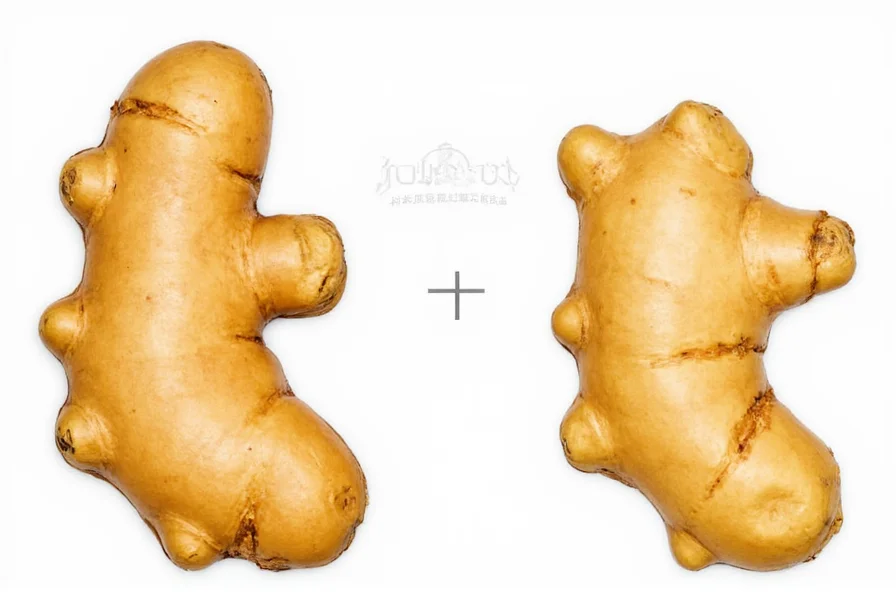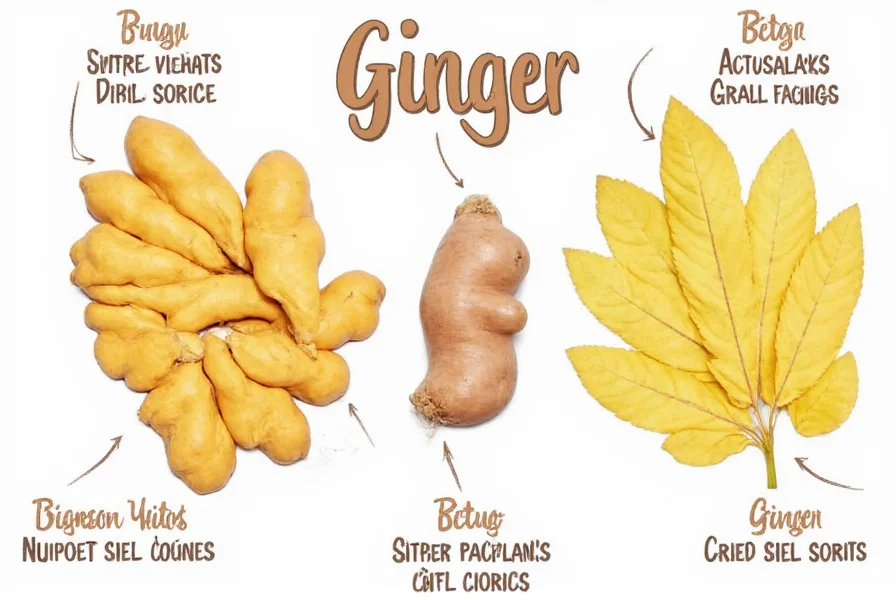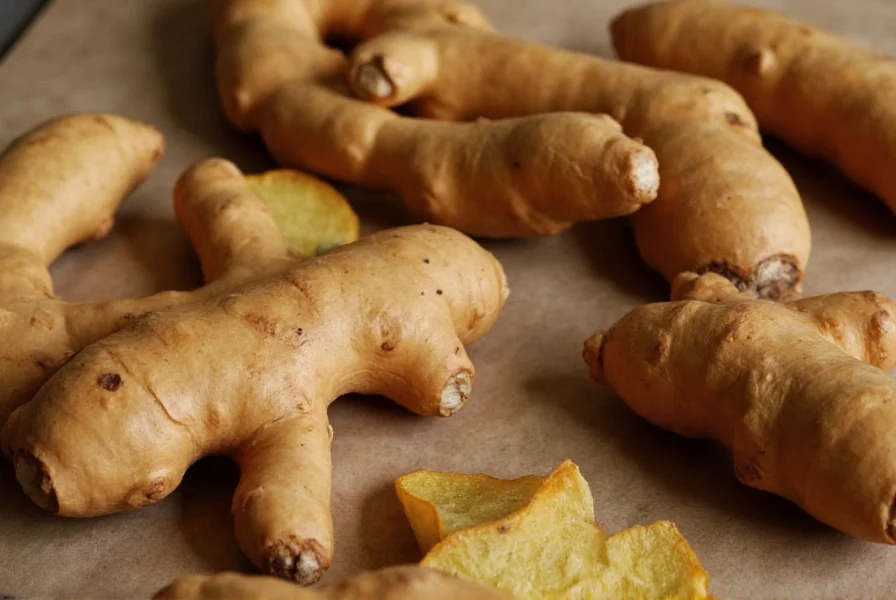Ginger imagery encompasses the distinctive visual traits that define fresh ginger rhizomes. When examining ginger root visually, several key characteristics determine quality and freshness. The outer skin typically ranges from pale yellow to light brown, with smoother skin indicating younger, more tender ginger. Mature ginger develops a thicker, fibrous bark that becomes increasingly wrinkled as it ages. High-quality ginger displays firmness to the touch with taut skin free from soft spots or mold.
Visual Characteristics of Fresh Ginger Root
The visual identification of premium ginger begins with understanding its fundamental appearance traits. Fresh ginger root exhibits a distinctive knobby structure with multiple finger-like projections extending from a central core. The skin texture varies significantly based on maturity - young ginger features thin, almost translucent skin that requires minimal peeling, while mature ginger develops a tougher, more fibrous exterior.
Color serves as a crucial visual indicator of ginger quality. Vibrant specimens display a consistent golden-yellow hue beneath the surface skin. When cut open, premium ginger reveals moist, fibrous flesh with a bright yellow to pale orange coloration. Dull or grayish tones inside the root typically indicate age or improper storage conditions. The visual contrast between fresh and deteriorating ginger becomes particularly evident at the cut surface, where quality ginger maintains its vibrant color rather than browning quickly.

Different Ginger Varieties and Their Visual Differences
Ginger varieties present distinct visual characteristics that affect both appearance and culinary applications. The common grocery store variety, often called Chinese or Canton ginger, features large, plump rhizomes with smooth skin and a strong, spicy flavor profile. This variety typically shows minimal branching with prominent knobs.
In contrast, Indian ginger tends to be smaller with more pronounced fingers and a slightly darker skin tone. Japanese or baby ginger represents the youngest harvest stage, displaying exceptionally smooth, almost paper-thin skin with a pinkish tinge at the growth tips. This variety's visual delicacy corresponds to its milder flavor and tender texture.
Wild ginger varieties present even more dramatic visual differences, often featuring irregular shapes and unique color variations. Some specialty cultivars develop distinctive purple hues near the growth nodes. Understanding these visual differences helps consumers select the appropriate ginger variety for specific culinary applications based on appearance alone.
| Ginger Variety | Visual Characteristics | Typical Use Cases |
|---|---|---|
| Common Grocery Ginger | Large rhizomes, smooth light brown skin, prominent knobs | General cooking, baking, medicinal preparations |
| Japanese Baby Ginger | Small size, paper-thin skin, pink growth tips, pale yellow flesh | Pickling, delicate dishes, sushi accompaniments |
| Indian Ginger | Smaller size, darker skin, pronounced fingers, fibrous texture | Spice pastes, traditional medicine, strong-flavored dishes |
How Visual Characteristics Relate to Quality and Flavor
The visual assessment of ginger provides reliable indicators of both quality and flavor intensity. Firmness represents one of the most critical visual-tactile indicators - high-quality ginger feels solid and heavy for its size, with no soft spots or wrinkles. The skin should appear tight and unwrinkled, as excessive wrinkling typically indicates moisture loss and age.
Visual inspection of the root's eyes or growth nodes offers additional quality insights. Healthy ginger displays small, tight buds rather than large, sprouting growths. The presence of visible mold, dark spots, or damp areas around the nodes signals deterioration. When selecting ginger, look for specimens with minimal branching, as excessive division often indicates older, more fibrous roots.
The visual characteristics of ginger directly correlate with its flavor profile. Younger ginger with smooth, thin skin typically offers a milder, more citrusy flavor with less heat. Mature ginger with thicker, more fibrous skin delivers a stronger, spicier bite with more pronounced pungency. Understanding these visual-flavor relationships allows for more precise ingredient selection based on recipe requirements.
Using Visual Cues to Select the Best Ginger
Mastering ginger imagery enables consumers to make informed selections at markets and grocery stores. When evaluating ginger visually, prioritize specimens with smooth, taut skin that shows no signs of shriveling. The ideal piece should feel heavy and solid, with minimal surface imperfections. Avoid ginger with soft spots, dark patches, or visible mold growth.
Examine the cut ends if available - fresh ginger displays moist, vibrant flesh without browning or dryness. For long-term storage considerations, select pieces with fewer growth nodes, as these will sprout more slowly. When comparing multiple options, choose ginger with consistent coloration throughout rather than specimens showing patchy discoloration.
Understanding ginger imagery extends to recognizing seasonal variations. Winter-harvested ginger typically features thicker skin and more intense flavor, while spring ginger offers thinner skin and milder taste. These seasonal visual differences help consumers select ginger appropriate for their intended use, whether for delicate sauces requiring subtle flavor or robust dishes needing pronounced ginger presence.

Common Visual Mistakes When Identifying Ginger
Several common visual misinterpretations can lead to poor ginger selection. Many consumers mistakenly believe that larger ginger pieces automatically indicate better quality, when in fact oversized specimens often become fibrous and woody. The visual appearance of ginger's surface wrinkles frequently causes confusion - while some texture is normal, excessive wrinkling typically signals age and moisture loss.
Another frequent visual error involves misjudging ginger freshness based solely on skin color. While pale yellow skin generally indicates quality, some naturally darker varieties might be incorrectly dismissed as inferior. Similarly, the presence of small root hairs is often misinterpreted as spoilage when it actually represents natural growth characteristics.
Understanding true visual indicators of deterioration versus natural appearance variations prevents unnecessary rejection of quality ginger. Recognizing that minor surface blemishes don't necessarily affect internal quality helps reduce food waste while ensuring optimal selection based on accurate visual assessment.
Frequently Asked Questions
What visual characteristics indicate fresh ginger?
Fresh ginger displays smooth, taut skin without excessive wrinkling, feels firm and heavy for its size, and shows no soft spots or mold. When cut, it reveals moist, vibrant yellow to pale orange flesh without browning. The growth nodes should appear small and tight rather than sprouted.
How can you visually distinguish between young and mature ginger?
Young ginger features thin, almost translucent skin that's easy to peel, with a pale yellow color and sometimes pinkish growth tips. Mature ginger has thicker, more fibrous brown skin, more pronounced wrinkles, and a stronger, more angular shape with prominent knobs. The flesh of young ginger is typically more tender and less fibrous.
What visual signs indicate ginger has gone bad?
Ginger that has spoiled shows visible mold growth, dark spots or patches, excessive wrinkling indicating moisture loss, soft or mushy areas when pressed, and separation of fibers. When cut open, bad ginger displays grayish or brown discoloration rather than vibrant yellow-orange color, and may have dry, brittle texture instead of moist flesh.
Does ginger color affect its flavor profile?
Yes, ginger color provides visual clues about flavor intensity. Generally, specimens with brighter yellow flesh offer milder, more citrusy flavor, while those with deeper orange tones deliver stronger, spicier heat. Young ginger with pale yellow color tends to be more delicate, while mature ginger with darker exterior skin typically provides more pronounced pungency. The visual appearance of growth nodes also indicates flavor development - tight buds suggest fresher, milder flavor while sprouted nodes indicate more intense heat.











 浙公网安备
33010002000092号
浙公网安备
33010002000092号 浙B2-20120091-4
浙B2-20120091-4